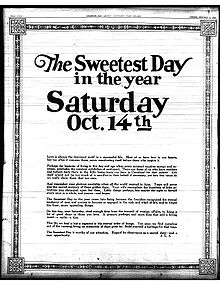| Revision as of 19:10, 20 January 2022 editIridescent 2 (talk | contribs)Autopatrolled, Extended confirmed users, New page reviewers, Pending changes reviewers, Rollbackers, Template editors78,734 editsm →Origin: Cleanup and typo fixing, typo(s) fixed: October 10, 1927 → October 10, 1927,Tag: AWB← Previous edit | Revision as of 22:35, 26 January 2022 edit undoBenpiano800 (talk | contribs)Extended confirmed users822 editsNo edit summaryTags: Mobile edit Mobile app edit Android app editNext edit → | ||
| Line 1: | Line 1: | ||
| {{Short description|Holiday}} | |||
| {{Use mdy dates|date=October 2018}} | {{Use mdy dates|date=October 2018}} | ||
| {{Infobox holiday | | {{Infobox holiday | | ||
Revision as of 22:35, 26 January 2022
Holiday
| Sweetest Day | |
|---|---|
| Observed by | Great Lakes region |
| Type | Local |
| Celebrations | Giving presents such as greeting cards and candy to loved ones. |
| Date | Third Saturday in October |
| 2024 date | October 19 (2024-10-19) |
| 2025 date | October 18 (2025-10-18) |
| 2026 date | October 17 (2026-10-17) |
| 2027 date | October 16 (2027-10-16) |
| Frequency | Annual |
Sweetest Day is a holiday that is celebrated in the Midwestern United States, parts of the Northeastern United States, and in Florida on the third Saturday in October. It is a day to share romantic deeds or expressions, and acts of charity and kindness. Sweetest Day has also been referred to as a "Hallmark holiday" or a "concocted promotion" created by the candy industry solely to increase sales of sweets.
Origin

The first Sweetest Day was on October 10, 1921, in Cleveland. The Cleveland Plain Dealer's edition of October 8, 1922, which chronicles the first Sweetest Day in Cleveland, states that the first Sweetest Day was planned by a committee of 12 confectioners chaired by candymaker C. C. Hartzell. The Sweetest Day in the Year Committee distributed over 20,000 boxes of candy to "newsboys, orphans, old folks, and the poor" in Cleveland. The Sweetest Day in the Year Committee was assisted in the distribution of candy by some of the biggest movie stars of the day including Theda Bara and Ann Pennington.
There were also several attempts to start a "Sweetest Day" in New York City, including a declaration of a Candy Day throughout the United States by candy manufacturers on October 8, 1922. In 1927, The New York Times reported that "the powers that determine the nomenclature of the weeks of October" decreed that the week beginning on October 10, 1927, would be known as Sweetest Week. On September 25, 1937, The New York Times reported under Advertising News and Notes that The National Confectioners Association had launched a "movement throughout the candy industry" to rank Sweetest Day with the nationally accepted Mother's Day, Father's Day, and St. Valentine's Day.
In 1940, another Sweetest Day was proclaimed on October 19. The promotional event was marked by the distribution of more than 10,000 boxes of candy by the Sweetest Day Committee. The candy was distributed among 26 local charities. 225 children were given candy in the chapel at the Society for Prevention of Cruelty to Children on October 17, 1940. 600 boxes of candy were also delivered to the presidents of the Jewish, Protestant and Catholic Big Sister groups of New York.
Regional importance
Retail Confectioners International describes the observance as "much more important for candymakers in some regions than in others (Detroit and Cleveland being the biggest Sweetest Day cities)". The popularity in Detroit was greatly perpetuated by the Sanders Candy Company. Frederick Sanders of Detroit was a large promoter of the holiday. In 2006, Hallmark marketed 151 greeting card designs for Sweetest Day. American Greetings marketed 178.
Criticism
Since Sweetest Day was invented by commercial interests which stood to profit from such a holiday, dissenting Cleveland residents refer to it as a "Hallmark holiday" (although it was not invented by the Hallmark Cards company).
References
- Sweetest Day, retrieved January 11, 2022
- Cridlin, Jay (October 21, 2006). "A sweet day for Hallmark". St Petersburg Times. Retrieved February 21, 2007.
- ^ Orsborn, Kimberly (October 20, 2006). "Sweetest Day born in Ohio". Mount Vernon News. Archived from the original on March 26, 2007. Retrieved February 21, 2007.
- ^ The Cleveland Plain Dealer, October 15, 2005.
- The Lindell Plain Dealer, October 8, 1921 and October 8, 1922.
- The New York Times, October 8, 1922.
- The New York Times, October 10, 1927.
- The New York Times, September 25, 1937.
- ^ The New York Times, October 18, 1940.
- Sweetest Day Archived October 6, 2006, at the Wayback Machine, retailerconfectioners.org. Retrieved on February 21, 2007.
- Grzegorek, Vince (October 16, 2015). "What's the deal with Sweetest Day bullshit, anyway?". Detroit Metro Times. Retrieved February 5, 2020.
- Arnett, Lisa. "Sweet wine o' mine". The Chicago Tribune. Archived from the original on March 10, 2007. Retrieved February 21, 2007.
Further reading
- Maud Lavin, ed. (October 4, 2004). The Business of Holidays. Monacelli. ISBN 1-58093-150-2.
- Leigh Eric Schmidt (1995). Consumer Rites: The Buying and Selling of American Holidays. Princeton University Press. ISBN 0691029806.
- Bennett Madison and James Dignan (December 28, 2002). I Hate Valentine's Day. Simon Spotlight Entertainment. ISBN 0-689-87372-7.